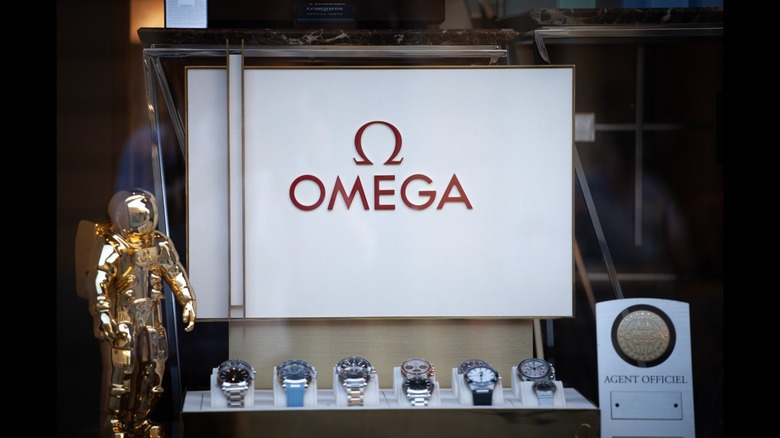This Rolex Datejust 41 Alternative Can Save You Money
The Rolex Datejust has a unique place in Rolex's lineup. A number of its lower-end references are some of the cheapest Rolex watches you can buy, but higher-end models are among the brand's most iconic offerings. Since the Datejust debuted in 1945, it's maintained a place as the archetypal luxury daily wearer: It's simple, versatile, and easily recognizable. The 41-millimeter Datejust 41 is Rolex's modern flagship size for this model, featuring a sleek case and the latest Caliber 3235 movement.
It's also pretty tricky to obtain. Chrono24 Magazine says that new Datejust 41 models often have a wait period of three to six months at an authorized dealer. Other reports from Luxury Bazaar stretched that estimate up to two years for the smooth-bezel variant and three years for references with a fluted bezel. Even if an authorized dealer had one in stock, a white-gold fluted-bezel model retails around $10,900 and even the all-steel, smooth-bezel version lists for $8,500. For both models, prices on the secondary market can go even higher.
If the wait and the price aren't worth it to you, you can get an Omega Constellation Globemaster that offers a similar dress-sport vibe, a fluted bezel, and one of the most advanced movements in the business. It is the first watch to be fully METAS Master Chronometer certified, and you can find a steel Globemaster with a leather strap for around $8,500 and a pre-owned piece closer to $5,000 on Chrono24 — thousands less than a Datejust 41.
Compare before you buy: Datejust 41 vs. Constellation Globemaster
At first glance, the Rolex Datejust 41 and the Omega Constellation Globemaster don't seem like natural rivals. The Datejust is the archetypal modern Rolex, while the Globemaster is a quieter revival of Omega's mid-century Constellation line. Even so, both were built to be versatile, water-resistant to 100 meters, and comfortable in both formal and informal clothing. They each tell the date and time, and they're both powered by advanced automatic movements without batteries.
Where they differ most is how the brands choose to present those features. The Datejust 41 wears as a full, modern, 41-millimeter watch, while the closest Globemaster match would be the 39-millimeter date model. Omega does offer a 41-millimeter Annual Calendar version, but the added thickness and month display make it less comparable to the Datejust. Both the Globemaster and the Datejust 41 can have fluted bezels, but they're also executed differently: The Rolex's bezel comes in warm white, yellow, or rose gold, while Omega uses a colder, scratchproof tungsten carbide.
The Globemaster may be the more affordable watch, but it also has arguably the better movement inside. Rolex's Caliber 3235 is robust by itself, with a 70-hour reserve and good accuracy. However, Omega counters with the Co-Axial Master Chronometer Caliber 8900, which keeps excellent time and shrugs off magnetic fields up to 15,000 gauss. That's why some reviewers on WatchCrunch have argued that the Globemaster is a better value — unless you're planning to resell it.
The prices on the new and used markets
When buying brand new, Globemaster and Datejust 41 references are not that far off in terms of prices. Omegas can be cheaper than Rolexes, but they're not exactly the low-cost Rolex alternative some other buyers may be looking for. To have a more comprehensive view of the price differences, you'll have to look at the different offerings under each model line. The real savings actually happen in the used markets.
The steel Rolex Datejust 41 with a smooth bezel carries an official retail price of about $8,500 and jumps around 10% in average resales according to WatchCharts. White-gold fluted versions are priced past $10,900 but can fetch over $13,000 on the secondary market. Meanwhile, steel-and-gold references retail around $15,000 or more, and still sell around MSRP used. That makes buying pre-owned expensive if you want to skip the waitlist.
On the flip side, a 39-millimeter steel-on-steel Omega Constellation Globemaster has a list price of about $8,900, yet you can often find new ones for sale from independent, non-authorized dealers for less than $7,000. Pre-owned, those same watches can drop to less than $5,000. Meanwhile, the 41-millimeter Annual Calendar, officially tagged around $10,000, frequently trades second-hand for $5,000, showing a potential 50% depreciation within a few years. But if even those prices are a little steep for you, another brand makes a Datejust alternative that's nearly identical and 20 times cheaper.

